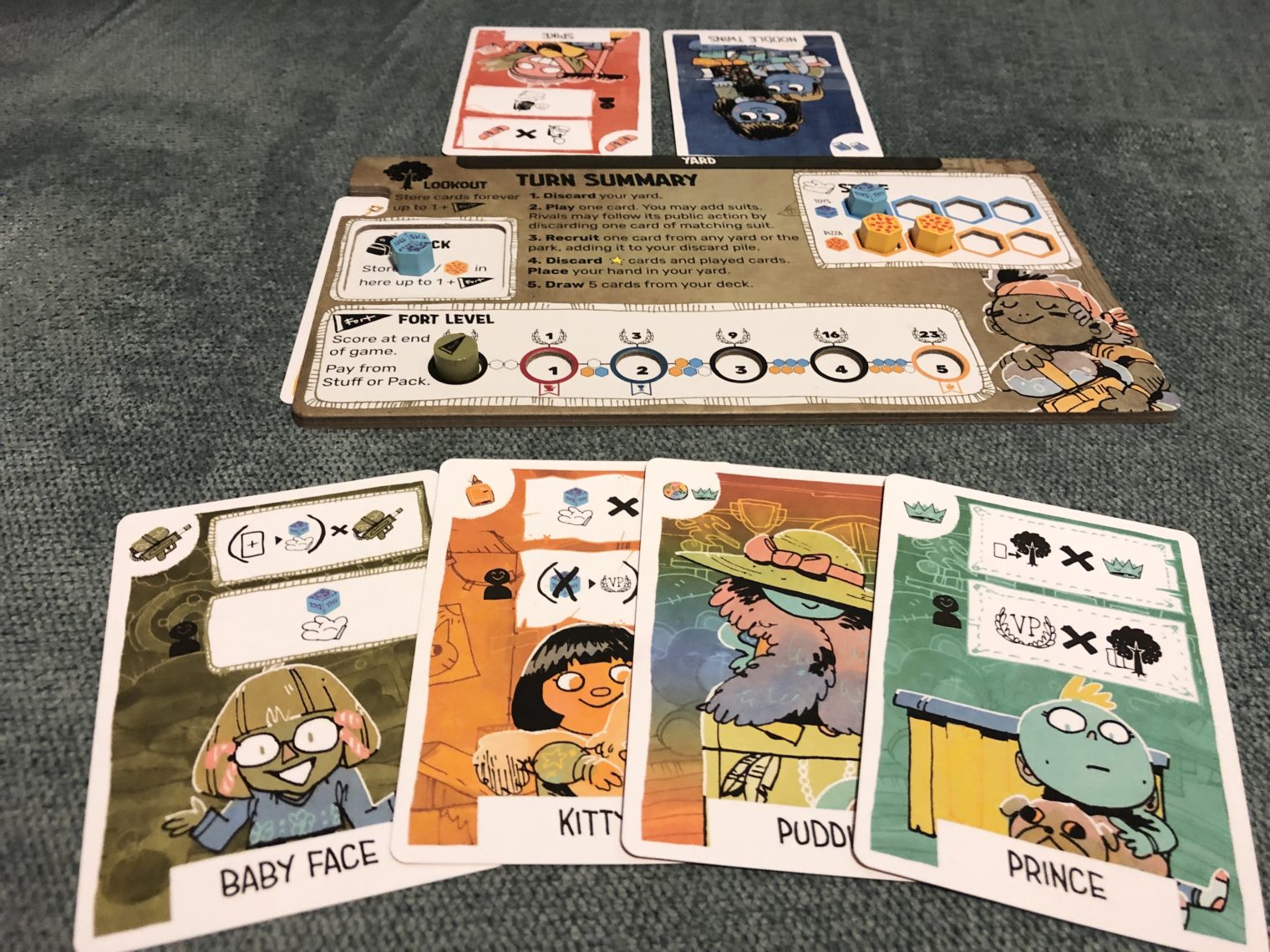So what’s all the fuss about this fort-building then? Well, Fort’s what I call a “stealth game”: it’s got an innocuous, inviting theme, with graphic design to match, which sends out a lite-game vibe but which actually has a tremendous amount going on.
Stealth games can be small card games, like Bugs on Rugs, or they can be splashy Ameritrashy, like Star Wars: The Queen’s Gambit or Duelosaur Island. They can be great ways to trick your non-gamer friends into catching the Tabletop bug–or they can be exercises in frustration for unwary buyers who find themselves with more than they bargained for.
It’s no surprise that Fort’s been published by Leder Games, who’ve also just issued not one but two expansions for its beloved Root franchise (which we’ll be covering, never you doubt). Root’s the picture postcard stealth game: come for the cute woodland animals, stay for the COIN-series multi-faction wargamery.
What you may not know is that Fort was originally a civ-themed game called SPQF. Its designer, Grant Rodiek, first came on the scene in 2012 with Farmageddon, a card game with a harvesting theme. Then in 2016 he came out with both the fantasy-themed poker-type game Hocus and the card-driven asymmetric dudes-on-a-map futuristic wargame Cry Havoc. Clearly cards are Rodiek’s jam, and he seems to be very adept at taking card-based mechanics and twisting them into original shapes.
SPQF, originally released in 2018, followed this template, taking the card-tucking, leading-and-following, and stacking limitation mechanics from 2005’s Glory to Rome and stirring in deckbuilding and resource management.
Rodiek acknowledges Leder’s role in developing his design further, both streamlining gameplay and changing the theme from civ-building in the ancient world to an idealized 1950s/1960s suburban landscape with free-range kids and an ever-shifting web of friendship and alliances. But it’s probably Kyle Ferrin’s artwork, with its bold palette and wide-eyed innocence that cements Fort’s status as a stealth game. Look how cute everything is! How hard could this game be?
Well, damn hard as it turns out. Not to learn or teach–as always, Leder’s rules and player aids really do, you know, aid players. But the layers of decision-making right from the get-go belie Fort’s childlike eye-candy appeal.

On your turn you play a card from hand, possibly buffed by one or more from the same suit to juice one or both of its actions in any order. Then in clockwise order other players can discard one card of the same suit to do your card’s “public” action (the other one is for you only). Actions revolve around gathering resources and using them either to generate VP’s or to improve the level of your Fort.
Then you recruit one new card either from the central “park” OR from any opponent’s “yard” of unused cards (more about this in a sec). Finally, you put all the cards you used this turn into your discard, and all the cards you didn’t use (except for your starting BFF’s, who never voluntarily desert you) into your yard–where they can be poached by other players on their turns–cue a Keanu Reeves “whoooaaaa”.
Game-end is triggered when one player reaches 25 VP’s or maxes out their Fort at Level 5, or the Park deck empties. Finish out the round, count up VP’s, and you’re done.
For deckbuilding veterans, there are two main ways the game subverts your instincts. First is the tension between on the one hand wanting/needing to specialize in just one or two suits so that you can make the most of your cards’ actions and the other the temptation to have at least some off-suit strength so you can leech off of opponents’ Public Actions (the psychology of which reminds me of Race For The Galaxy).
Making this even more difficult to navigate is the way unused cards-in-hand go to your Yard, where they can be Recruited by other players. A player who puts together a game-winning engine can find their cards being poached literally from under their noses. This results in cards constantly moving back and forth between players’ decks, a kind of interplay I just haven’t seen in any other deckbuilder except for the little-known-but-deserves-more-attention Superhot: TCG.

All of this means the kind of engine-building you depend on in traditional deckbuilders is much less viable; your deck is changing much more frequently and unpredictably, requiring you to be flexible and adaptable in the moment. You can’t rest on your laurels and coast to victory–which I for one like.
So is Fort worth the hype? Well, it’s certainly a solid, original design with tons of interesting decisions and great thematic graphic design. If you and/or your group prefer multiplayer solitaire or are prone to Analysis Paralysis, you should probably give this a pass. But if you like deckbuilders and plenty of player interaction, then you will probably enjoy it.
Thanks to Leder Games for providing a review copy of Fort.
Comments
No comments yet! Be the first!